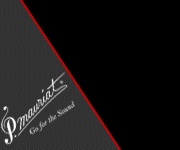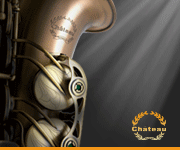 Forgot Username? Forgot Password?
Forgot Username? Forgot Password?
 SELMER Balanced Action "Dorsey" (1937-1939)
SELMER Balanced Action "Dorsey" (1937-1939)
The Dorsey model Selmer was first introduced in May of 1937 almost two years after Selmer had begun production of the balanced action line of saxophones. These rare limited production horns have a balanced action body tube with retro-fit Radio Improved keywork including the eariler Radio Improved bell, table mechanism and bell to body brace. The upper stack is almost 100% balanced action. However, the miracle happens on the bottom half of the horn. The most obvious departure from the balanced action is that the bell keys are located on the opposite side of the bell (left as you're playing the horn).
The Dorsey Selmer was only offered in alto or tenor. There were two runs of Dorsey Selmer saxes. The first series (as pictured here) was in 1937 (serial number range 23xxx-24xxx). This first series Doresy is charcacterized by having all radio improved keyguards. While, the bell is engraved with the appropriate balanced action floral engraving pattern with sailboat portrait, it differs slightly from the typical balanced action engraving pattern. First, the stamping is of the earlier Radio Improved era complete with Henri Selmer signture, serial number, and Radio Improved stamp. Second, the sailboat portrait is positioned on the bottom right side of the bell (as you're playing) as oppoed to the middle of the front section of the bell. Further, the serial number on the back of the body tube differs from that on the bell and is partially covered over by the retro-fit Eb key guard just as the B/Bb keyguard cage is soldered in place right over the bell engraving.
The second series Dorsey Selmer was in 1938-39 (serial number range (26xxx-28xxx). These horns are noted for having a sheet metal B/Bb keyguard soldered over the top of the wire guard. Other minor differences exist between this later version and the first series Dorsey. First, the serial number is not located on the bell of the instrument nor is the radio improved stamp. Second, the portrait engraving pattern is located in the same spot as you would expect for a balanced action (mid way up the front side of the bell). Lastly, the C and Eb key guards are balanced action-like and soldered on with a triangular flange and therefore do not cover up the serial number stamp on the back-side of the body tube.
Both the first and second series Dorsey Selmers are retro-fit balanced actions that are characterized by having a balanced body tube and radio improved keywork. Probably less than 100 of these horn were ever produced.
The origin of this model is not known for certain. However, one story is that the Dorsey band, devote Selmer players, all preferred the earlier radio improved keywork, but liked the way the new balanced action performed. Accordingly, Selmer agreed to make a limited run of altos and tenors that met these design specifications. However, this seems a bit far fetched as discussed below.
Another more likely scenerio is that Selmer did inventory in 1937 and realized that they had a good number of left over bells and plenty of extra keywork from the earlier saxophone models. Instead of wasting these parts Selmer may have used them to make a limited run of horns that were given to various performers who endorsed Selmer saxophones (Jimmy Dorsey and his sax section being the most prominent of the period).
Most likely a bit of both of these scenerios were at play in the creation of this horn. While Jimmy Dorsey did have a lot of influence at this time period, its doubtful that Selmer would have altered its production simply at his request. Re-tooling back to the radio improved keywork after switching production to the BA for a small run of horns would not be cost-effective. Selmer has always been a forward looking company and its almost inconceivable that they would admit publically that previous radio improved model harbored any advantage over the newly improved balanced action, especially given the aggressive advertising campaign that was unveiled to introduce the balanced action. Also, to my knowledge there were no ads run or any printed material from Selmer mentioning this retro-balanced action model.
A scenerio where Selmer would have used these horns to give to Selmer artists endorsing their instruments as opposed to offering them to the public is not at all unreasonable. Indeed, Jimmy Dorsey did play a cigar cutter alto prior to 1937 and may have had some influenced with Selmer in regard to this sax. It may have very well been the case that the Jimmy Dorsey sax section preferred the radio improved keywork that they were used to (although we certainly know today that the BA key is much improved). In any event, history has recorded that the Dorsey Band did indeed use these horns and Jimmy and his entire sax section can be seen in many photos playing and holding this model of Selmer. Thus this anomaly in the Selmer sax line has been informally called the "Dorsey model" by professionals saxophone players since its inception.
Enjoy the photos. This is truly an exceptional saxophone and a wonderful piece of the Selmer legacy.
[less]The Dorsey model Selmer was first introduced in May of 1937 almost two years after Selmer had begun production of the balanced action line of saxophones. These rare limited production horns have a balanced action body tube with retro-fit Radio Improved keywork including the eariler Radio Improved... [more]
Serial Numbers:
| Beginning Year | Beginning Number |
|---|---|
| 1937 | 23800 |
| 1938 | 27000 |







